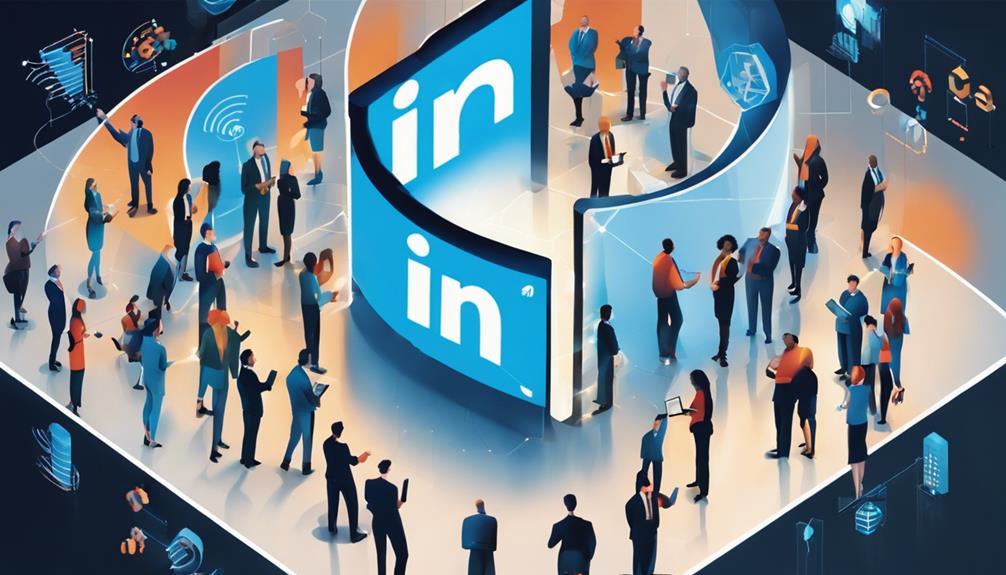
To navigate future industry trends on LinkedIn, you need to tap into its suite of tools and resources. Start by following thought leaders and participating in relevant groups to catch early insights and discussions that signal shifting trends. Utilize LinkedIn's analytics to track which innovations are gaining traction, and adjust your networking to connect with key influencers. Stay updated on sector-specific challenges and opportunities, especially in rapidly evolving fields like healthcare, renewable energy, and AI. As you engage more deeply, you'll turn LinkedIn into a powerful asset for predicting and adapting to industry shifts, which will unlock further insights into carving a successful path in your career landscape.
Understanding LinkedIn's Role in Industry Trends

LinkedIn isn't just a platform for networking; it's a vital tool for understanding and predicting industry trends. When you dive into the various features it offers, you'll uncover how it actively shapes your perception of where industries are heading.
First off, consider the wealth of articles shared by thought leaders and innovators. By following these influencers, you're exposed to forward-thinking ideas and emerging concepts well before they hit mainstream markets. It's not just about who you know; it's about what you know and how quickly you adapt this knowledge.
Then there's the data aspect. LinkedIn provides insights into job market trends and skills in demand, which reflect shifting industry priorities. For instance, a sudden spike in AI-related job postings might hint at increased adoption of AI technologies across sectors. You've got to keep an eye on these patterns—they're often early indicators of significant changes.
Moreover, the groups and discussions on LinkedIn offer a live pulse on industry sentiment. Engaging here allows you to gauge the immediate reaction of professionals to market shifts or technological advancements. It's like having a finger on the industry's pulse, ensuring you're not just keeping up but staying ahead.
Identifying Key Sectors to Watch
Often, pinpointing sectors poised for growth involves keen observation and strategic analysis.
You've got to keep an eye on market shifts and consumer behavior, as they're crucial indicators of what's gaining traction. On LinkedIn, following influential leaders and companies in various industries can provide insights into which sectors are heating up.
Start by looking at sectors that consistently show strong job growth and robust professional engagement on LinkedIn. Industries like healthcare, renewable energy, and financial services are often at the forefront.
Pay close attention to the discussions happening in specialized groups and the articles shared by industry insiders. They're likely talking about challenges and opportunities that could signal sector vitality.
Remember, it's not just about what's trending now, but what's sustainable long term. Look for sectors that invest in innovation and skills development, as these are likely to endure and evolve.
You'll also want to monitor the LinkedIn news feed for announcements of major investments and partnerships in different industries. These can be precursors to significant growth, so don't overlook them.
Analyzing Emerging Technology Influences

With the landscape of technology ever-evolving, it's crucial you understand how these advancements impact various industries. Emerging technologies like artificial intelligence (AI), blockchain, and the Internet of Things (IoT) are reshaping business landscapes across the board.
You've got to stay informed to remain competitive.
AI, for instance, is revolutionizing customer service and data analysis. Companies are utilizing AI to automate responses and glean insights from massive data sets, allowing them to make more informed decisions swiftly.
If you're in retail or e-commerce, integrating AI could vastly improve your efficiency and customer satisfaction.
Blockchain technology, on the other hand, is making waves in sectors like finance and supply chain management. Its ability to provide secure, transparent transactions is especially valuable in industries where trust is paramount.
Consider how adopting blockchain could safeguard your transactions and enhance transparency in your operations.
Lastly, IoT is transforming everything from manufacturing to home automation. By connecting devices and enabling them to communicate, IoT can help you streamline operations and offer new services.
Whether you're in manufacturing or tech, exploring IoT applications could significantly boost your operational efficiency.
Understanding these technologies will help you spot trends and adapt, keeping your business ahead of the curve.
Leveraging LinkedIn for Market Research
As you explore emerging technologies to keep your business competitive, don't overlook the power of LinkedIn for conducting robust market research. By tapping into LinkedIn's vast network of professionals, you can gain invaluable insights into industry trends, consumer behaviors, and competitive landscapes.
Start by using LinkedIn's advanced search features to identify and follow key influencers and thought leaders in your sector. Observing their posts and articles will provide you with cutting-edge knowledge directly from industry insiders. You'll stay updated on the latest technologies and market dynamics, which can guide your strategic decisions.
Moreover, engage with relevant groups and discussions. These forums are goldmines for firsthand opinions and experiences. Participating actively can also help you gauge the market's reaction to certain technologies or innovations. You can ask direct questions and receive feedback that's often more candid and practical than traditional market research reports.
Lastly, LinkedIn's analytics tools allow you to track engagement and trends within your network. This data can highlight potential areas for growth or investment. By analyzing who interacts with your content and how, you'll better understand your audience and refine your market strategies accordingly.
Networking Strategies for Industry Leaders

To effectively expand your influence as an industry leader, prioritize building a strategic network on LinkedIn. Start by identifying and connecting with key influencers within your industry. These are the individuals who drive conversations and shape trends.
Don't just add them; engage with their content thoughtfully and consistently to get on their radar.
Tailor your LinkedIn profile to highlight your expertise and achievements. This makes you more attractive to potential connections who can help propel your career forward.
Remember, it's not just about who you know, but who knows you. Make your presence known by sharing insights and participating in relevant discussions. This visibility establishes your authority and attracts more professional opportunities.
Use LinkedIn's advanced search features to filter and find professionals who align with your strategic goals.
Reach out with personalized messages that reference specific interests or projects they've worked on. It's these personalized touches that can turn a cold contact into a valuable connection.
Predictive Analytics and Industry Forecasts
Predictive analytics tools are revolutionizing how industry leaders forecast future trends and market demands. You can leverage these tools to gain a competitive edge by understanding what's next before it even happens. They sift through vast amounts of data, identifying patterns that might escape the human eye. This isn't just about reacting faster; it's about proactive strategies that position you ahead in your field.
Imagine being able to predict consumer behavior, supply chain snags, or market shifts before they're evident to everyone else. That's the power you wield with predictive analytics. By analyzing historical data and current trends, these tools provide forecasts that aren't merely educated guesses but data-driven insights.
You'll find that integrating predictive analytics into your business strategy could transform your approach. It's about making informed decisions that not only keep up with the pace of industry changes but also anticipate them. This means better resource allocation, optimized operations, and ultimately, enhanced profitability.
Start small if you're new to this. Even basic models can provide valuable insights that refine your decision-making process. As you grow more comfortable, your models will become more sophisticated, and your foresight sharper.
Don't just stay in the game; set the rules.
The Impact of Global Events on Industries

Global events frequently shape the landscape of industries in profound ways. Whether it's a geopolitical conflict, a global health crisis, or sweeping regulatory changes, these events can pivot market demands and reshape business strategies overnight.
You've likely noticed how quickly industries can either falter or flourish under new global conditions. For instance, the travel and tourism sector might experience a sharp decline during a pandemic, whereas e-commerce and digital communication platforms could see unprecedented growth.
As you navigate your career or business strategy on LinkedIn, it's crucial to stay informed about these shifts. Global events don't just alter the immediate landscape; they also set the stage for long-term changes in consumer behavior and operational norms.
By understanding these dynamics, you can better anticipate opportunities and risks within your industry. Moreover, these events often lead to innovative adaptations. Businesses that swiftly adapt to new realities tend to survive and even thrive.
You'll want to watch how companies in various sectors respond to global challenges, as these responses can offer valuable insights into resilience and adaptability. Keep an eye on industry leaders and emerging challengers on LinkedIn, as they often set trends that define the future of their sectors.
Skills Development for Future Trends
Understanding how global events reshape industries highlights the importance of continuously developing your skills to stay relevant and competitive. As you navigate your career on LinkedIn, identifying and cultivating the right skills can set you apart in a dynamic job market.
First, focus on digital literacy. No matter your field, technology is likely weaving through its core processes. You'll need to be comfortable with digital tools and platforms. It's not just about knowing how to use them, but understanding how they can drive business or improve performance.
Next, consider adaptability and emotional intelligence. These soft skills help you manage change and connect with colleagues in meaningful ways, enhancing teamwork and productivity. They're increasingly prized in almost every industry.
You should also look into data analytics. With data driving decisions in sectors from marketing to healthcare, being able to interpret and leverage data can make you a valuable asset.
Case Studies of Successful Industry Adaptations

Let's examine some real-world examples where companies successfully pivoted during industry upheavals.
Take Netflix, for instance. Originally a DVD rental service, Netflix shifted its business model to online streaming as digital technology evolved. This pivot not only captured millions of subscribers worldwide but also set a new standard in the entertainment industry.
Similarly, Adobe transformed its business by transitioning from selling boxed software to a subscription-based model. This change addressed the growing need for scalable solutions and regular updates, significantly boosting Adobe's revenue and market relevance.
You've also got Microsoft, which refocused its strategy towards cloud computing with the launch of Azure. By embracing cloud technology early, Microsoft ensured its competitive edge in a rapidly shifting tech landscape.
These companies didn't just react to changes; they anticipated them and adapted their business models accordingly.
Their success demonstrates the importance of staying agile and responsive in a dynamic business environment. By keeping an eye on emerging trends and being ready to pivot, they managed to stay ahead of the curve and thrive.
This proactive approach is crucial for any business aiming to survive and flourish amidst constant change.
Future-Proofing Your Career on LinkedIn
Drawing from the adaptability showcased by leading companies like Netflix and Microsoft, you can similarly future-proof your career through strategic use of LinkedIn. Start by optimizing your profile. Highlight your skills and accomplishments, ensuring you update these regularly to reflect your professional growth and relevance in your field. Use keywords that resonate with future industry trends and the roles you're aiming for.
Next, build a robust network. Connect with industry leaders, peers, and influencers who can provide insights and opportunities that align with your career aspirations. Engaging with content that reflects your professional interests and specialties also keeps you visible and relevant.
Furthermore, consider writing articles or sharing posts that showcase your expertise and insights into future trends. This not only strengthens your profile but also establishes you as a thought leader in your industry.
Lastly, leverage LinkedIn's learning resources. Stay ahead by completing courses and certifications related to upcoming technologies and practices in your field. This demonstrates your commitment to continuous learning and adaptability—key traits that employers look for in a rapidly evolving marketplace.
Frequently Asked Questions
How Do I Recover a Hacked Linkedin Account?
To recover your hacked LinkedIn account, immediately change your password and report the breach to LinkedIn's support team. Check your account settings for any unauthorized changes and update your security settings accordingly.
What Is Linkedin's Policy on Third-Party Data Sharing?
LinkedIn's policy on third-party data sharing limits how your information is shared. They require consent before providing your data to external parties, ensuring you have control over your personal and professional information.
How Often Should I Update My Linkedin Profile Photo?
You should update your LinkedIn profile photo every one to two years to keep your appearance current and reflect any significant changes in your professional image, ensuring you always look approachable and relevant.
Can Linkedin Endorsements Affect Job Search Visibility?
Yes, LinkedIn endorsements can boost your job search visibility as they highlight your skills and expertise, making you more attractive to recruiters. It's worth actively seeking endorsements from colleagues and industry peers.
What Are the Costs of Linkedin Premium Subscriptions?
LinkedIn Premium subscriptions vary in cost depending on the plan. You'll pay more for features like InMail messages, advanced search, and detailed insights, ranging from about $30 to $120 per month.
Conclusion
Now you're equipped to navigate the shifting landscapes of industry trends on LinkedIn. Keep your eye on emerging sectors and tech advancements. Use LinkedIn's rich data for sharp market insights and connect with industry leaders to stay ahead. Remember, global events will continue to shape markets, so adapt swiftly. By upgrading your skills and learning from successful case studies, you'll future-proof your career. Embrace these strategies, and you'll not just adapt—you'll lead.






